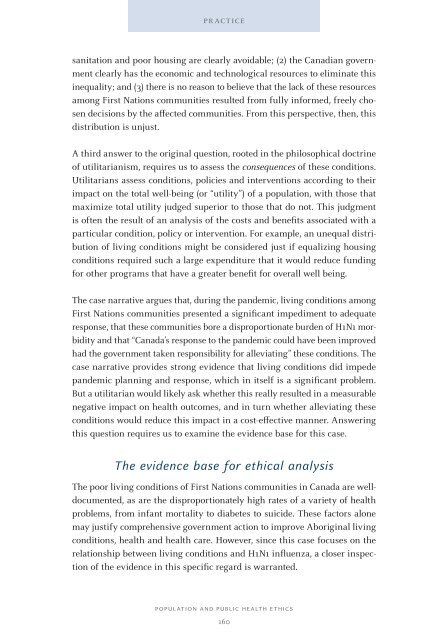PoPulationand Public HealtH etHics
PoPulationand Public HealtH etHics
PoPulationand Public HealtH etHics
You also want an ePaper? Increase the reach of your titles
YUMPU automatically turns print PDFs into web optimized ePapers that Google loves.
practice<br />
sanitation and poor housing are clearly avoidable; (2) the Canadian government<br />
clearly has the economic and technological resources to eliminate this<br />
inequality; and (3) there is no reason to believe that the lack of these resources<br />
among First Nations communities resulted from fully informed, freely chosen<br />
decisions by the affected communities. From this perspective, then, this<br />
distribution is unjust.<br />
A third answer to the original question, rooted in the philosophical doctrine<br />
of utilitarianism, requires us to assess the consequences of these conditions.<br />
Utilitarians assess conditions, policies and interventions according to their<br />
impact on the total well-being (or “utility”) of a population, with those that<br />
maximize total utility judged superior to those that do not. This judgment<br />
is often the result of an analysis of the costs and benefits associated with a<br />
particular condition, policy or intervention. For example, an unequal distribution<br />
of living conditions might be considered just if equalizing housing<br />
conditions required such a large expenditure that it would reduce funding<br />
for other programs that have a greater benefit for overall well being.<br />
The case narrative argues that, during the pandemic, living conditions among<br />
First Nations communities presented a significant impediment to adequate<br />
response, that these communities bore a disproportionate burden of H1N1 morbidity<br />
and that “Canada’s response to the pandemic could have been improved<br />
had the government taken responsibility for alleviating” these conditions. The<br />
case narrative provides strong evidence that living conditions did impede<br />
pandemic planning and response, which in itself is a significant problem.<br />
But a utilitarian would likely ask whether this really resulted in a measurable<br />
negative impact on health outcomes, and in turn whether alleviating these<br />
conditions would reduce this impact in a cost-effective manner. Answering<br />
this question requires us to examine the evidence base for this case.<br />
The evidence base for ethical analysis<br />
The poor living conditions of First Nations communities in Canada are welldocumented,<br />
as are the disproportionately high rates of a variety of health<br />
problems, from infant mortality to diabetes to suicide. These factors alone<br />
may justify comprehensive government action to improve Aboriginal living<br />
conditions, health and health care. However, since this case focuses on the<br />
relationship between living conditions and H1N1 influenza, a closer inspection<br />
of the evidence in this specific regard is warranted.<br />
PoPulation anD <strong>Public</strong> <strong>HealtH</strong> <strong>etHics</strong><br />
160
















